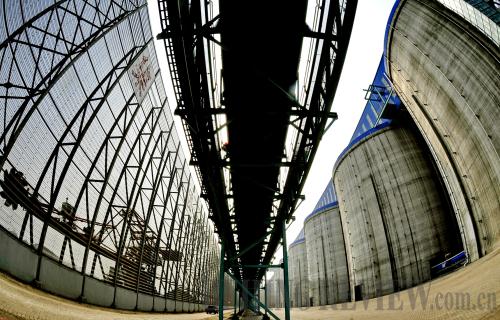|
 |
|
FIGHTING FINE PARTICLES: Pollution control facilities at Huanghua Port in Hebei Province (YANG SHIYAO) |
"The thick smog and haze have pressured policymakers to consider a tougher approach against air pollution," Chai said.
In the new plan, the Central Government pledged to invest 1.7 trillion yuan ($277.32 billion) in the fight against air pollution over the next five years.
The primary goal is to reduce PM2.5 levels. Experts consider PM2.5 to be one of the most dangerous pollutants, warning that it can become lodged deep in the lungs and cause health problems.
According to the plan, China will increase clean energy production and cut consumption of coal, which supplies most of the country's electricity and remains a major source of air pollution. The country aims to reduce coal consumption to less than 65 percent of the country's total primary energy use by 2017, it says.
Use of clean energy such as natural gas and coal-bed methane is to be increased and construction projects that fail to pass environmental evaluations will not be allowed to continue.
To further cut pollution, combined heat and power plants will gradually replace decentralized coal-fired boilers in industries such as chemical engineering, papermaking, dyeing and tanning.
In addition, China will promote the refitting of various industries, and further tighten control over industries that are highly polluting and energy-intensive.
One of the most important issues is curbing excess output in industries that emit high levels of pollution, consume high amounts of energy and are heavily reliant on natural resources, said Wang Jinnan. The sectors targeted by the latest action plan include iron and steel, cement, electrolytic aluminum and flat glass.
According to the document, an original target set for 2015 to close outdated production capacity in key industrial sectors will be achieved by 2014.
Heavier penalties will be imposed for violations of environmental, energy conservation and safety requirements, while energy conservation and environmental protection standards will be strictly implemented to support the phasing out of excess production capacity, it adds.
Although eliminating outdated methods of industrial production may have negative effects on local economies, Wang Jinnan said that the action plan will boost green industries, stimulating GDP growth of about 2.5 trillion yuan ($407.83 billion).
Cleaner fuel
The new action plan also aims to control vehicle emissions. China has been the world's top automobile producer and exporter for four consecutive years. During that period, the number of registered motor vehicles in the country grew by 12 percent every year, reaching 80 million at the end of 2011.
According to the MEP, airborne pollutants emitted by automobiles are also increasing, accounting for more than 20 percent of airborne pollutants.
"The main factor affecting vehicle emissions is the quality of fuel. Improving fuel quality can reduce pollution and help prevent smog," said Zhou Dadi, an expert with the China Energy Research Society.
On September 17, the MEP unveiled phase 5 of its emission standards for light vehicles.
The new standards, coming eight years after phase 4, reduce the limit for nitrogen oxides by 25-28 percent. It also requires the emissions of fine particulate matter to be slashed by 82 percent.
The new standards are expected to help reduce emissions of nitrogen oxide by 90,000 tons and fine particles by 20,000 within five years.
Under the country's fuel quality improvement timetable, phase 4 standards for gasoline and diesel should be met by the start of 2014 and the start 2015 respectively. Both gasoline and diesel are expected to meet phase 5 standards by the start of 2018.
| 